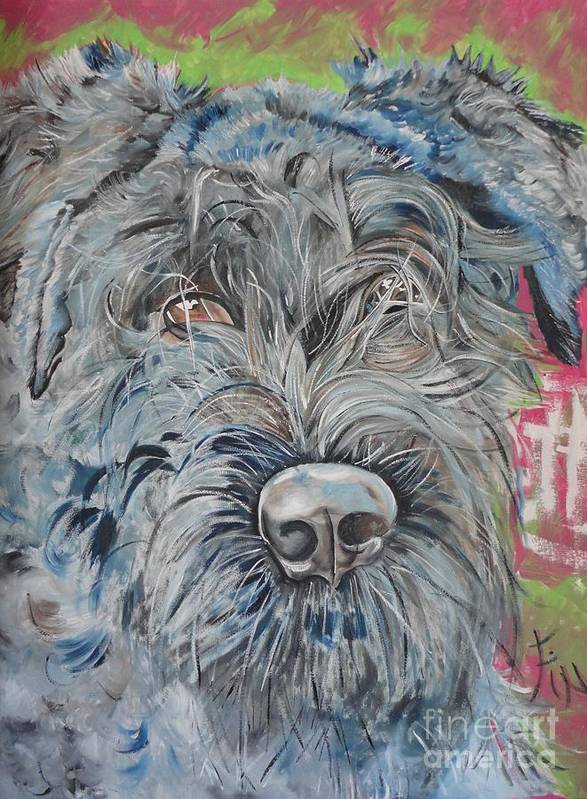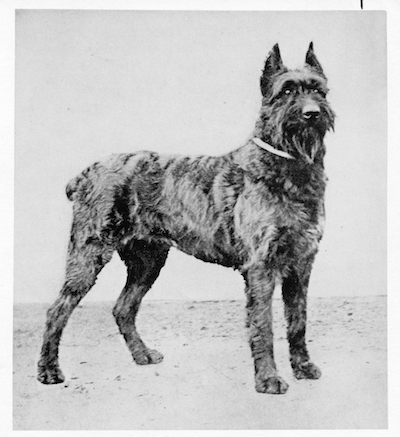
France and Belgium each claimed the Bouvier des Flandres as their own, but war is an “equal opportunity” force of destruction, and both were devastated by WWI. France had the most casualty percentage of deaths comparing to all the other participants, while Belgium saw the destruction of its historic buildings, and nearly 7,000 of its civilians executed by the German army. As a breed, the Bouvier had little chance of survival, and indeed, most Bouviers were lost in bombings, through abandonment when their owners fled, or because they were shot on sight.
Bouviers who didn’t die were put into service pulling ambulance litters or cannons, serving as messengers or pack dogs, or searching battlefields for wounded soldiers. These were dangerous jobs and the breed paid the price, but some survived their dangerous tasks. The most influential of these dogs was Ch. Nic de Sottegem. Several breed experts are of the opinion that had it not been for Nic, there might not be any Bouviers today.

This is not Nic, but his granddaughter, “Belga de la Gendarmerie.’ She was the dam of the first two Dutch bred Bouviers to become Netherlands Champions, and the foundation of the entire Dutch Bouvier movement
Nic had been owned by a Bouvier fancier living near the city of Poperinge in southern West Flanders, but the dog was bought during the war by an Belgian army veterinarian Captain (later Major) Barbry (also seen as Darby). Nic was trained as a military dog, particularly as a “trench-dog,” and served for three years during which time Barbry did what he could to keep Nic well. After the fighting stopped, Barbry started a careful breeding program with the dog, though one source, Robert Pollet, differs in describing Nic’s time after the war; according to Pollet, Nic went to the Sottegem Kennel owned by Major Barbry‘s brother, and then to the “de la Lys” Kennel, owned by Mr. Gryson.’
Sources agree, however, that at the Olympic dog show in Antwerp in 1920, Barbry showed Nic who took first place over 16 other Bouviers. Nic was described by the judge, M. Charles Huge, as an ideal representative of the breed and added: “Nic is the ideal type of the Bouvier. He has a short body, with well developed ribs, short flanks, strong legs, good feet, long and oblique shoulders. His head is of a good shape with somber eyes and an ideal courageous expression. His hair is dry and dark. The tail should not have been cut so short. I hope that dog will have numerous progeny.”
He did. Among his offspring were Prince d’Or, Ch. Draga, Coralie, Goliath de la Lys, Lyda, Nora, Ch. Dragon de la Lys, and others. These dogs gathered together one day at Ghent so that a group of experts that included V. Tenret, V. Taeymans, Count de Hemptinne, Captain Binon, Mr. A. Gevaert – and yes, judge Charles Huge, could examine and measure each dog. Nic and his offspring became the basis of a new, more uniform standard. Breeders not only worked to replicate Nic’s good points, but relied heavily on his progeny to rebuild breed numbers.
Although Nic died in 1926, he had stamped himself on the breed, and his many descendants became foundation stock. Through them, Nic appears in almost every modern-day pedigree. Indeed, he is considered the father of the modern Bouvier. Sadly, we weren’t able to find an image of Nic, but did “score” one of his granddaughter, Belga de la Gendarmerie.
Image: Dog of Flanders by PainterArtist FIN is available as fine art, and in home decor and lifestyle items here
